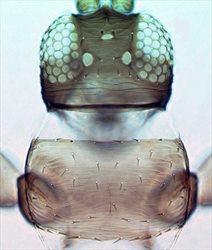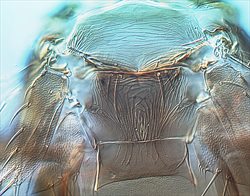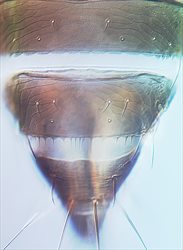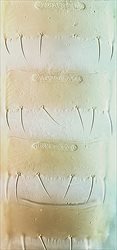
Female

Head & pronotum

Antenna

Antenna

Meso & metanotum

Tergites VII–X

Male abdominal sternites IV–VII

Male sternites

Fore wing
Both sexes fully winged. Female body brown (rarely yellow), tarsi, fore tibiae and antennal segment III paler; fore wings weakly shaded to light brown with base paler. Antennae 8-segmented, III–IV with sense cone small and forked. Head wider than long; 3 pairs of ocellar setae, pair III small, arising between hind ocelli; 4 pairs of smallpostocular setae. Pronotum with transverse lines of sculpture, no long setae; posterior margin with 7 pairs of setae, median posteromarginals scarcely longer than remaining marginals. Mesonotal and metanotal campaniform sensilla present (more rarely absent). Metanotum with lines of sculpture converging posteromedially; median setae arise at anterior margin. Mesofurca with spinula. Fore wing first and second veins each with complete row of setae; clavus with 6 veinal setae. Tergites without craspeda; V–VII without ctenidia, VIII with paired weakly developed ctenidia anterolateral to spiracle, posteromarginal comb comprising about 6 long microtrichia medially with smaller triangular teeth laterally. Sternites without discal setae; VII with setae S1 arising at margin.
Male similar to female but smaller, sometimes paler; sternites III–VII with transverse pore plate; sternite VIII posterior margin with long slender microtrichia arising from triangular bases, preceding sternites sometimes with posteromarginal microtrichia.
Species of the genus Pseudanaphothrips do not have tergal ctenidia as well-formed as in Frankliniella species, but share many character states with the members of that genus (Mound & Palmer, 1981). Most of the nine species in Pseudanaphothrips are from Australia. P. achaetus is the only member of the genus lacking elongate pronotal posteroangular setae.
Apparently highly polyphagous, because in Australia this thrips is found in the flowers of plants from many different families.
Not known in Europe, although in Britain a population was found in 2000 in a greenhouse at the Royal Botanic Gardens, Kew, on Scaveola plants that had been imported from Australia (Collins, 2010a). The population was eradicated by the plant health authorities. It is also known from New Zealand (Mound & Walker, 1982), as well as California and Hawaii, presumably distributed by the horticultural trade from Australia.
THRIPIDAE - THRIPINAE
Pseudanaphothrips achaetus (Bagnall)
Pseudothrips achaetus Bagnall, 1916: 398
Collins DW (2010a) Thysanoptera of Great Britain: a revised and updated checklist. Zootaxa 2412: 21–41.
Mound LA & Palmer JM (1981) Phylogenetic relationships between some genera of Thripidae (Thysanoptera). Entomologica Scandinavica Supplement 15: 153–170.
Mound LA & Walker AK (1982) Terebrantia (Insecta: Thysanoptera). Fauna of New Zealand 1: 1–113.